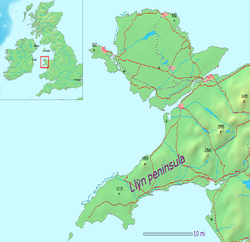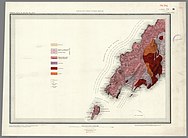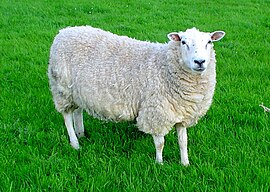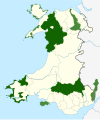Llŷn Peninsula


The Llŷn Peninsula (
Historically, the peninsula was travelled by pilgrims en route to Bardsey Island (Welsh: Ynys Enlli), and its relative isolation has helped to conserve the Welsh language and culture, for which the locality is now famous. This perceived remoteness from urban life has lent the area an unspoilt image which has made Llŷn a popular destination for both tourists and holiday home owners. Holiday homes remain contentious among locals, many of whom feel they are priced out of the housing market by incomers. From the 1970s to the 1990s, a group known as Meibion Glyndŵr claimed responsibility for several hundred arson attacks on holiday homes using incendiary devices, some of which took place in Llŷn.
The Llyn Area of Outstanding Natural Beauty covers approximately 62 sq mi (160 km2).[1]
Etymology
The name Llŷn is sometimes spelled Lleyn in English, although this spelling is now less common. The name is thought to be of Irish origin, and to have the same root –
History
Following the death of
The Welsh Triads record regional resistance to Edwin's incursions into Gwynedd by a regional ruler Belyn ap Cynfelyn and his Gosgordd who were allied with Cadwallon ap Cadfan.[3] In subsequent years Llŷn was raided by vikings, most notably by Olaf in the late 10th century.[4]
The most rural parts are characterised by small houses, cottages and individual farms, resembling parts of south west
Farming was originally simple and organic, but underwent major changes after the
Medieval administration
During the Middle Ages the cantref of Llŷn was divided into 3 cymydau, those being Dinllaen, Cafflogion and Cymydmaen, with their respective capitals at Din Llaen, Denio and Neigwl.[6] After the Edwardian Conquest some of these settlements became free boroughs like Denio and other like Neigwl faded into obscuirty.[7]
Geography
Llŷn is an extensive plateau dominated by numerous volcanic hills and mountains. The largest of these is
Geology

The geology of Llŷn is complex: the majority is formed from volcanic rocks of the
The area was overrun by Irish Sea ice during the ice ages and this has left a legacy of boulder clay and of meltwater channels.
Protected sites
Llŷn is notable for its large number of protected sites, including a
Lleyn sheep

The peninsula is the original home of the
Welsh language
Until at least the 1960s, a number of Welsh monoglots still lived in the Llŷn Peninsula.[10] However, before 2001 there had been a decline in Welsh speakers in Gwynedd, which includes the Llŷn Peninsula.[11] According to the 2001 census the number of Welsh speakers in Wales increased for the first time in over 100 years, with 20.5 per cent of a population of over 2.9 million claiming fluency in Welsh. The 2001 Census also showed that 73.1% of the population of Llŷn could speak Welsh. Additionally, 28 per cent of the population of Wales claimed to understand Welsh. However, the number of Welsh speakers declined in Gwynedd from 72.1 per cent in 1991 to 68.7 per cent in 2001.[11] By 2003, however, a survey of schools showed that just over 94 per cent of children between the ages of 3 and 15 were able to speak Welsh, making Llŷn one of the foremost heartlands of the language, although, as in the rest of north west Wales, many people are concerned that the influx of English speakers is damaging the standing of Welsh and threatening its future as a living community language in the area.[12] The Welsh Language and Heritage Centre of Nant Gwrtheyrn is situated on the north coast.
Tân yn Llŷn 1936
Concern for the Welsh language was ignited in 1936 when the United Kingdom government settled on establishing a bombing school at
Relationship with the property market
The decline in the use of the Welsh language in Llŷn has been attributed to a rise in property prices. Local Welsh speakers are increasingly unable to afford housing in the area as the rise in house prices has outpaced average earnings in Wales. On the other hand, there has been an influx of non-Welsh speakers purchasing properties for retirement or holiday homes.[15][16] The issue of locals being priced out of the local housing market is common to many rural communities throughout Britain, but in Wales the added dimension of language further complicates the issue, as many new residents do not learn the Welsh language.[17][18][19][20]
Governance
The whole of Llŷn is governed by Cyngor Gwynedd, a unitary authority established in 1996. The area had traditionally formed part of Caernarfonshire, for which an elected county council had been formed in 1889. Caernarfonshire was abolished in 1974 and incorporated into the new county of Gwynedd, which became a unitary authority under the 1996 reorganisation.[21]
Llŷn Rural District, based in Pwllheli, was created under the Local Government Act 1894 from the area of Pwllheli Rural Sanitary District. At the time it covered 91,449 acres (37,008 hectares) and consisted of 30 civil parishes, although the number was subsequently reduced. At the 1901 census it had a population of 16,816. Under a County Review Order in 1934, 18 parishes were abolished with their areas distributed among other parishes; a new parish of Buan was formed by the merger of Ceidio and Llanfihangel Bachellaeth; and the parish of Dolbenmaen was transferred from Glaslyn Rural District. Five years later, in 1939, Edern was abolished and incorporated into Nefyn.[22] The rural district was abolished in 1974, with its area being included in the Dwyfor District of Gwynedd, which was itself abolished in 1996, when Gwynedd became a unitary authority. At the time of abolition, the rural district covered 114,232 acres (46,228 ha) and had a population at the 1971 census of 15,190.[22]
Pwllheli Municipal Borough was the successor to a free borough which was granted a charter by
Criccieth Urban District was created under the Local Government Act 1894,[26] and covered the area of the former borough, which had been abolished in 1886 by the Municipal Corporations Act 1883.[27] The borough charter had been granted by Edward I in 1284.[28] The urban district covered 472 acres (191 ha) and at the 1901 census had a population of 1,406.[29] By the time of abolition and incorporation into Dwyfor in 1974, it covered 1,721 acres (696 ha), and had a population at the 1961 census of 1,672.[26]
List of ancient parishes
References
- ^ "Llyn AONB". ahne-llyn-aonb.org. Retrieved May 6, 2015.
- ISBN 978-1843239017.
- ISBN 9781783161454.
- ISBN 9780198704911.
- ^ Llŷn Area of Outstanding Natural Beauty : Management Plan : An Assessment of the Area and its Resources. Retrieved 14 January 2010.
- ISBN 978-0-19-820878-5.
- ^ Gwynedd Archaeological Trust : Historic Landscapes : Pwllheli, Deneio and Penmaen Archived 2012-01-18 at the Wayback Machine. Retrieved 14 January 2010.
- ^ British Geological Survey, 1994. 1:250,000 scale geological map, The Rocks of Wales/Creigiau Cymru
- ^ "Rare Welsh bee features on new series of stamps". bbc.co.uk. Retrieved 2015-08-18.
- ^ "Llŷn's Monoglots in 1968, Rhiw.com". www.rhiw.com. Retrieved 2019-01-26.
- ^ a b Dr John Davies (2003-02-14). "Census shows Welsh language rise". BBC News. Retrieved 2010-12-06.
- National Assembly for WalesCulture Committee.
- ISBN 0-14-014581-8, page 593
- ^ a b Davies, op cit, page 592
- ^ "Property prices in England and Wales". BBC News. 2001-08-08. Retrieved 2010-12-06.
- ^ "House prices outpacing incomes". BBC News. 2001-12-03. Retrieved 2010-12-06.
- ^ "Apology over 'insults' to English". BBC News. 2001-01-19. Retrieved 2010-12-06.
- ^ "Double tax for holiday home owners". BBC News. 1999-12-16. Retrieved 2010-12-06.
- ^ "Controls on second homes reviewed". BBC News. 2001-09-05. Retrieved 2010-12-06.
- ^ "Gwynedd considers holiday home curb". BBC News. 2002-04-09. Retrieved 2010-12-06.
- ^ A Vision of Britain Through Time : Caernarfonshire County Archived 2011-06-04 at the Wayback Machine. Retrieved 14 January 2010.
- ^ a b A Vision of Britain Through Time : Llŷn Rural District[permanent dead link]. Retrieved 12 January 2010.
- ^ Archifau Cymru : Caernarfon Record Office : Pwllheli Borough Council Records Archived 2011-07-16 at the Wayback Machine. Retrieved 14 January 2010.
- ^ University of Essex : Online Historical Population Reports : Enumeration Abstract 1841. Retrieved 14 January 2010.
- ^ a b A Vision of Britain Through Time : Pwllheli Municipal Borough[permanent dead link]. Retrieved 14 January 2010.
- ^ a b c "A Vision of Britain Through Time: Criccieth Urban District". Visionofbritain.org.uk. Retrieved 2010-12-06.[permanent dead link]
- ^ Office of Public Sector Information : Municipal Corporations Act 1883[permanent dead link]. Retrieved 14 January 2010.
- ^ Cymdeithas Hanes Eifionydd : The Town and Borough of Criccieth Archived 2011-10-07 at the Wayback Machine. Retrieved 14 January 2010.
- ^ University of Essex : Online Historical Population Reports : Caernarfonshire 1901. Retrieved 14 January 2010.
- ^ A Vision of Britain Through Time : Aberdaron Civil Parish Archived 2012-06-30 at archive.today. Retrieved 12 January 2010.
- ^ A Vision of Britain Through Time : Abererch Civil Parish Archived 2011-06-04 at the Wayback Machine. Retrieved 12 January 2010.
- ^ A Vision of Britain Through Time : Bardsey Island Civil Parish Archived 2011-06-04 at the Wayback Machine. Retrieved 12 January 2010.
- ^ A Vision of Britain Through Time : Bodferin Civil Parish Archived 2011-06-04 at the Wayback Machine. Retrieved 12 January 2012.
- ^ A Vision of Britain Through Time : Botwnnog Civil Parish Archived 2011-06-04 at the Wayback Machine. Retrieved 12 January 2010.
- ^ A Vision of Britain Through Time : Bryncroes Civil Parish Archived 2011-06-04 at the Wayback Machine. Retrieved 12 January 2010.
- ^ A Vision of Britain Through Time : Buan Civil Parish Archived 2011-06-04 at the Wayback Machine. Retrieved 12 January 2010.
- ^ A Vision of Britain Through Time : Carnguwch Civil Parish Archived 2011-06-04 at the Wayback Machine. Retrieved 12 January 2010.
- ^ A Vision of Britain Through Time : Ceidio Civil Parish Archived 2011-06-04 at the Wayback Machine. Retrieved 12 January 2010.
- ^ A Vision of Britain Through Time : Dolbenmaen Civil Parish Archived 2011-06-04 at the Wayback Machine. Retrieved 12 January 2010.
- ^ A Vision of Britain Through Time : Edern Civil Parish Archived 2011-06-04 at the Wayback Machine. Retrieved 12 January 2010.
- ^ A Vision of Britain Through Time : Llanaelhaearn Civil Parish Archived 2011-06-04 at the Wayback Machine. Retrieved 12 January 2010.
- ^ A Vision of Britain Through Time : Llanarmon Civil Parish Archived 2011-06-04 at the Wayback Machine. Retrieved 12 January 2010.
- ^ A Vision of Britain Through Time : Llanbedrog Civil Parish Archived 2011-06-04 at the Wayback Machine. Retrieved 12 January 2010.
- ^ A Vision of Britain Through Time : Llandegwning Civil Parish Archived 2011-06-04 at the Wayback Machine. Retrieved 12 January 2010.
- ^ A Vision of Britain Through Time : Llandudwen Civil Parish Archived 2011-06-04 at the Wayback Machine. Retrieved 12 January 2010.
- ^ A Vision of Britain Through Time : Llanengan Civil Parish Archived 2011-06-04 at the Wayback Machine. Retrieved 12 January 2010.
- ^ A Vision of Britain Through Time : Llanfaelrhys Civil Parish Archived 2011-06-04 at the Wayback Machine. Retrieved 12 January 2010.
- ^ A Vision of Britain Through Time : Llanfihangel Bachellaeth Civil Parish Archived 2011-06-04 at the Wayback Machine. Retrieved 12 January 2010.
- ^ A Vision of Britain Through Time : Llangian Civil Parish Archived 2011-06-04 at the Wayback Machine. Retrieved 12 January 2010.
- ^ A Vision of Britain Through Time : Llangwnnadl Civil Parish Archived 2011-06-04 at the Wayback Machine. Retrieved 12 January 2010.
- ^ A Vision of Britain Through Time : Llangybi Civil Parish Archived 2011-06-04 at the Wayback Machine. Retrieved 12 January 2010.
- ^ A Vision of Britain Through Time : Llaniestyn Civil Parish Archived 2011-06-04 at the Wayback Machine. Retrieved 12 January 2010.
- ^ A Vision of Britain Through Time : Llannor Civil Parish Archived 2011-06-04 at the Wayback Machine. Retrieved 12 January 2010.
- ^ A Vision of Britain Through Time : Llanystumdwy Civil Parish Archived 2011-06-04 at the Wayback Machine. Retrieved 12 January 2010.
- ^ A Vision of Britain Through Time : Mellteryn Civil Parish Archived 2011-06-04 at the Wayback Machine. Retrieved 12 January 2010.
- ^ A Vision of Britain Through Time : Nefyn Civil Parish Archived 2011-06-04 at the Wayback Machine. Retrieved 12 January 2010.
- ^ A Vision of Britain Through Time : Penllech Civil Parish Archived 2011-06-04 at the Wayback Machine. Retrieved 12 January 2010.
- ^ A Vision of Britain Through Time : Penllyn Civil Parish Archived 2011-06-04 at the Wayback Machine. Retrieved 12 January 2010.
- ^ A Vision of Britain Through Time : Penrhos Civil Parish Archived 2011-06-04 at the Wayback Machine. Retrieved 13 January 2010.
- ^ A Vision of Britain Through Time : Pistyll Civil Parish Archived 2011-06-04 at the Wayback Machine. Retrieved 13 January 2010.
- ^ A Vision of Britain Through Time : Tudweiliog Civil Parish Archived 2011-06-04 at the Wayback Machine. Retrieved 13 January 2010.




































